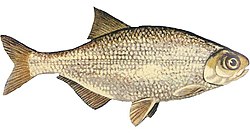| Osteoglossomorpha Temporal range: | |
|---|---|
 | |
| Arapaima (Arapaima gigas) | |
| Scientific classification | |
| Kingdom: | Animalia |
| Phylum: | Chordata |
| Class: | Actinopterygii |
| Clade: | Osteoglossocephala |
| Cohort: | Osteoglossomorpha Greenwood, Rosen, Weitzman & Myers, 1966 |
| Orders | |
and see text | |
Osteoglossomorpha is a group of bony fish in the Teleostei.



